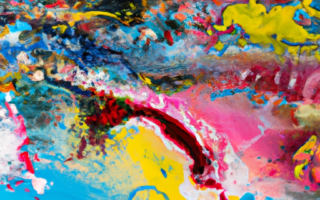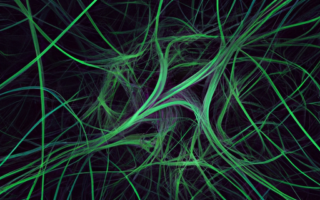A Brief History of Abstract Art: Uncovering its Origins and Influences
Understanding the concept of abstract art is crucial for anyone interested in exploring the world of contemporary art. Abstract art represents a departure from the traditional representation of objects and subjects found in traditional art forms such as realism or impressionism. Instead, it focuses on conveying emotions, ideas, or concepts through shapes, colors, and forms that may not necessarily have an obvious connection to reality.
The origins of abstract art can be traced back to the late 19th and early 20th centuries, amidst a period of significant artistic experimentation and philosophical questioning. Artists began to challenge the traditional notion of art as mere imitation of reality and sought new ways to express their inner thoughts and emotions through their artwork.
Kandinsky is often credited as one of the pioneers of abstract art. In 1911, he created one of the first purely abstract paintings, „Composition V,” which marked a turning point in the history of art. Kandinsky believed that art should be devoid of any representation of the physical world and instead should aim to evoke spiritual and emotional responses from the viewer.
Another influential figure in the development of abstract art was Piet Mondrian. Mondrian’s signature style evolved from early figurative paintings to an abstract style characterized by simplified geometric shapes and primary colors. His famous paintings, such as „Composition with Red, Yellow, and Blue,” exemplify his belief in the universality of form and color as the means to achieve harmony and balance.
Abstract art was also greatly influenced by the philosophical and scientific ideas of the time. The rise of Freud’s psychoanalysis and the exploration of the subconscious mind played a role in inspiring artists to delve deeper into their own inner worlds and translate their emotions and thoughts onto the canvas.
The impact of non-Western art, particularly African and Native American art, cannot be overlooked when discussing the origins and influences of abstract art. Artists such as Pablo Picasso and Henri Matisse were heavily influenced by the bold, expressive forms and use of symbolism found in these art forms. This influence can be observed in Picasso’s iconic painting „Les Demoiselles d’Avignon,” which showcases his incorporation of African masks and geometric abstraction.
Abstract art has evolved and diversified over the years, with various movements and artists pushing boundaries and exploring new avenues of expression. From the abstract expressionism of Jackson Pollock to the minimalist approach of artists like Donald Judd, abstract art continues to captivate and challenge audiences.
In conclusion, understanding the origins and influences of abstract art provides valuable insights into its evolution as a prominent form of artistic expression. From the pioneering works of Kandinsky and Mondrian to the cultural and philosophical influences that shaped the movement, abstract art continues to push boundaries and inspire artists and art enthusiasts alike.
The Evolution of Abstract Art: From Kandinsky to Pollock
Understanding the concept of abstract art requires delving into its origins and evolution, as different artists have contributed to its development over time. One significant aspect of abstract art’s evolution is the progression from the works of Wassily Kandinsky to Jackson Pollock.
Wassily Kandinsky, a Russian painter and art theorist, is often considered the pioneer of abstract art. In the early 20th century, Kandinsky began to explore the possibility of creating art that is independent of visual representation. He believed that pure abstraction could evoke emotional responses and spiritual experiences. Kandinsky’s paintings, like „Composition VII” and „Yellow-Red-Blue,” demonstrate his use of color, line, and form to convey emotions and ideas.
As abstract art continued to evolve, artists like Piet Mondrian and Kazimir Malevich experimented with non-objective compositions and geometric forms. Mondrian’s grids of vertical and horizontal lines, as seen in his famous artwork „Composition with Red, Yellow, and Blue,” aimed to achieve a universal visual language. Meanwhile, Malevich’s „Black Square” challenged traditional notions of art by presenting a simple black square on a white canvas, eliminating any representational elements.
However, it was the American artist Jackson Pollock who revolutionized abstract art in the mid-20th century. Pollock’s unique approach involved dripping and pouring paint onto canvas placed on the floor, allowing him to create dynamic and unpredictable compositions. His famous „drip paintings,” such as „No. 5, 1948,” captured movement, energy, and spontaneous expression.
The evolution of abstract art from Kandinsky to Pollock signifies a shift in artistic perspectives and techniques. While Kandinsky sought to evoke emotions and spiritual experiences through color and form, Pollock focused on the physical act of painting itself, using it as a means of personal expression. This transition exemplifies the diverse interpretations and advancements within the realm of abstract art.
In conclusion, understanding abstract art entails exploring its evolution over time. From the pioneering works of Kandinsky to the revolutionary approach of Pollock, abstract art has continually pushed the boundaries of artistic expression. By examining these artists and their contributions, we can gain a deeper appreciation for the rich history and development of abstract art.
Unlocking the Symbolism in Abstract Art: Exploring Meanings and Interpretations
Wznosząc się ponad konwencje tradycyjnego przedstawiania rzeczywistości, sztuka abstrakcyjna fascynuje i zaskakuje swoją nieujawnioną symboliką. Odkrywanie i odczytywanie znaczeń obecnych w tego rodzaju dziełach stanowi fascynującą podróż w głąb artystycznej wyobraźni.
Początki sztuki abstrakcyjnej sięgają pierwszych dekad XX wieku. Jednym z prekursorów tego ruchu był Wassily Kandinsky, rosyjski malarz i teoretyk sztuki. Kandinsky wierzył, że sztuka powinna angażować emocje i dążyć do wywołania wewnętrznych doświadczeń. Jego dzieła stanowiły eksperymentalne połączenie kolorów, linii i form, które miały na celu wyrażenie abstrakcyjnych idei i emocji.
Symbolika w sztuce abstrakcyjnej jest często subtelna i subiektywna. Każdy widz może odkryć w niej coś innego i własnoręcznie interpretować przekazy artysty. Bez wiążących przedstawień rzeczywistości, obrazy abstrakcyjne stwarzają przestrzeń dla indywidualnych spostrzeżeń i refleksji. Często artysta wykorzystuje różne techniki, takie jak nakładanie farby, grawerowanie czy kolaż, aby stworzyć wielowymiarową kompozycję, która pobudza wyobraźnię.
Jednym z najbardziej znanych przykładów rozumienia symboliki w abstrakcji jest cykl obrazów „Kompozycje” Kandinsky’ego. Przez kombinację geometrycznych kształtów, dynamicznych linii i bogatych kolorów, artysta inspirował się duchowością i dążył do przekazania wizji transcendencji.
Interpretowanie sztuki abstrakcyjnej to nie tylko odkrywanie ukrytych znaczeń, ale także doświadczanie i reakcja na emocje, które dzieła te wywołują. Widzowie często opisują swoje wrażenia jako spontaniczne, visceralne i nieuzasadnione racjonalnie. To właśnie w przypadku abstrakcji można czerpać nieskończoną inspirację i doznawać niemożliwych do wyrażenia słowami doznań.
Wnioskując, sztuka abstrakcyjna może być pojmowana jako metaforyczny język, w którym artysta wyraża swoje uczucia i myśli. Odkrywanie symboliki w abstrakcji zachęca do poszukiwań, refleksji i otwiera przestrzeń dla indywidualnych interpretacji. Bez względu na to, jakie są nasze odczucia wobec sztuki abstrakcyjnej, jej rola jako formy wyrazu daleko wykracza poza zwykłą reprezentację rzeczywistości.
Contemporary Abstract Art: Pushing Boundaries and Challenging Perceptions
Contemporary abstract art has emerged as a powerful force in the art world, pushing boundaries and challenging perceptions. This artistic movement is characterized by its innovative approach, often defying traditional forms and techniques. Understanding the concept of contemporary abstract art requires delving into its origins and evolution.
Contemporary abstract art builds upon the foundations laid by abstract expressionism, which gained prominence in the mid-20th century. Artists like Jackson Pollock, Mark Rothko, and Willem de Kooning pioneered this movement, emphasizing spontaneity, emotional expression, and the exploration of the subconscious mind.
However, contemporary abstract art takes these principles to new heights by incorporating diverse mediums, unconventional materials, and innovative techniques. Artists today are not bound by the limitations of the canvas, venturing into installations, sculptures, digital art, and even performance art.
One notable characteristic of contemporary abstract art is its ability to challenge traditional ideas of representation and interpretation. Unlike realistic or figurative art, contemporary abstract art often lacks recognizable imagery. Instead, it evokes emotions, sensations, and concepts through the use of colors, shapes, and textures.
Contemporary abstract artists experiment with the interplay of light, color, and form to create dynamic and thought-provoking pieces. They encourage viewers to engage with their work on a deeper level, allowing for personal interpretations and connections.
Another aspect of contemporary abstract art is its emphasis on individuality and personal expression. Each artist brings a unique perspective and voice, reflecting their experiences, culture, and worldview. This diversity of styles and approaches adds depth and richness to the contemporary abstract art movement.
Contemporary abstract art also challenges the notion of permanence and ephemerality. Artists embrace imperfections, transient materials, and temporary installations, highlighting the transient nature of existence and creation. This creates a sense of constant evolution and encourages viewers to question their perception of art and reality.
In conclusion, contemporary abstract art pushes boundaries and challenges perceptions, expanding the possibilities of artistic expression. Through its innovative approaches, incorporation of diverse mediums, and emphasis on personal interpretation, this art movement continues to evolve and captivate audiences. Exploring the world of contemporary abstract art offers a glimpse into the ever-changing landscape of artistic creativity.



